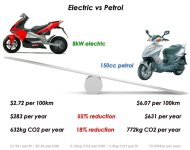I did some searching to find if this was covered, but only found small snippets here and there.
It was something that I always thought was insignificant until I started testing out my own build and was pretty amazed at the difference between the energy used by the scooter via the Cycle Analyst and the energy used to charge the batteries back up to full charge via a Kill-a-Watt plug mounted device.
When I tested my scooter I managed to use 2.265 kWh on the CA, but it took 2.99 kWh to charge back up. Basically 24% of the energy seems to have been lost by the time the motor sees it. I found this link this quote matches exactly what I found. "For me, based on my Cycle Analyst and Kill-a-watt, 1 Wh delivered to the motor requires about 1.3-1.4 Wh pulled out of the wall"
https://endless-sphere.com/forums/viewtopic.php?f=2&t=63840
It made me think of questions relating to this.
What are the variables on this? Charger efficiency, controller efficiency, temperature, battery type, state of charge, charging rate, discharge rate, copper losses?
I am using a Zivan charger, GBS cells and Kelly KEB controller.
1 Charging and discharging rate. If I charge at say 5 amps vs 12 amps is it likely that the higher amps can create more losses than 5 amps? Conversely if I discharge at 2C vs 1C on the low C rated GBS cells does this incur losses? Basically is keeping in with the correct C rating of a cell important for efficiency? (I gather heat production in unsuitable cell is an indication of poor energy conversion.... to a point?)
2 Chemistry - The GBS cells are apparently high internal resistance cells. Does this resistance create more losses than low IR cells? Also as the IR increases through age does this lower efficiency?
3 Temperature - Does the lower temp increase IR and thus reduce efficiency? (this is my understanding that it does?)
4 Charging range - Would charging up to say 70% - 80% be more efficient than, the final 20%? Does charging the final 20% incur an efficiency penalty?
..... I am sure there are many other points, but these were some that I was pondering on.
In this link I also saw a point about losses from plug to motor.
http://www.greencarreports.com/news/1090685_life-with-tesla-model-s-one-year-and-15000-miles-later
It was something that I always thought was insignificant until I started testing out my own build and was pretty amazed at the difference between the energy used by the scooter via the Cycle Analyst and the energy used to charge the batteries back up to full charge via a Kill-a-Watt plug mounted device.
When I tested my scooter I managed to use 2.265 kWh on the CA, but it took 2.99 kWh to charge back up. Basically 24% of the energy seems to have been lost by the time the motor sees it. I found this link this quote matches exactly what I found. "For me, based on my Cycle Analyst and Kill-a-watt, 1 Wh delivered to the motor requires about 1.3-1.4 Wh pulled out of the wall"
https://endless-sphere.com/forums/viewtopic.php?f=2&t=63840
It made me think of questions relating to this.
What are the variables on this? Charger efficiency, controller efficiency, temperature, battery type, state of charge, charging rate, discharge rate, copper losses?
I am using a Zivan charger, GBS cells and Kelly KEB controller.
1 Charging and discharging rate. If I charge at say 5 amps vs 12 amps is it likely that the higher amps can create more losses than 5 amps? Conversely if I discharge at 2C vs 1C on the low C rated GBS cells does this incur losses? Basically is keeping in with the correct C rating of a cell important for efficiency? (I gather heat production in unsuitable cell is an indication of poor energy conversion.... to a point?)
2 Chemistry - The GBS cells are apparently high internal resistance cells. Does this resistance create more losses than low IR cells? Also as the IR increases through age does this lower efficiency?
3 Temperature - Does the lower temp increase IR and thus reduce efficiency? (this is my understanding that it does?)
4 Charging range - Would charging up to say 70% - 80% be more efficient than, the final 20%? Does charging the final 20% incur an efficiency penalty?
..... I am sure there are many other points, but these were some that I was pondering on.
In this link I also saw a point about losses from plug to motor.
http://www.greencarreports.com/news/1090685_life-with-tesla-model-s-one-year-and-15000-miles-later


